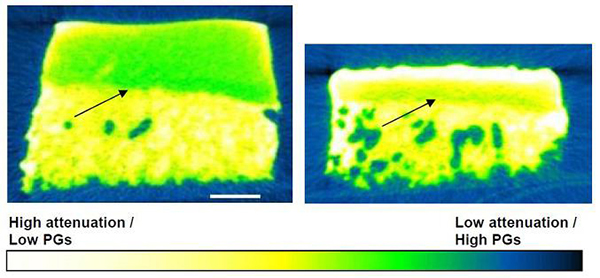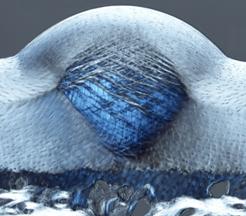Research
My general field of interest is biomechanics--the application of mechanical engineering principles to biological systems. Biomechanics can take the form of: (1) sports biomechanics, in which the goal is to optimize human movement in an athletic setting (i.e., run faster, jump higher, throw farther), or (2) studying injury or disease to better understand the risk factors and consequences of various disorders.
I have primarily focused on orthopedic biomechanics and my main area of study has been exploring the mechanical and biological factors involved in the initiation and progression of osteoarthritis. This has required an approach spanning multiple length scales. Studies at the whole-body level all the way down to investigation of the micromechanical environment of individual cells are complementary and can provide a deeper understanding of the disease process.

EPIC-uCT scan of articular cartilage attached to underlying subchondral bone. The image on the left represents cartilage taken from the region of the tibial plateau that is not covered by the meniscus while the image on the right represents cartilage that is covered by the tibial plateau. The meniscus-covered cartilage has a thick region near its surface with low proteoglycan (PG) content. Regional variations in cartilage content, structure, and mechanical properties may make the knee susceptible to developing OA following a destabilizing event such as ACL injury.

Differential interference contrast (DIC) image of articular cartilage chemically fixed in a mechanically loaded state. Deformation of the fibrillar collagen network in healthy samples creates 'shear bands,' which aren't observed in even mildly degenerate cartilage.

Microstructure of the meniscus--a fibrocartilaginous structure in the knee. There is compelling evidence that some types of knee OA begin with meniscal degradation, although the mechanics of meniscal tissue haven't been studied as thoroughly as cartilage.